通过组件图视图构建架构模型
您可以从架构视图库的组件图画布中编辑 System Composer™ 模型。
创建一个新的组件图视图。
交互式添加、编辑和删除组件、端口和连接。
为视图应用构造型并创建自定义查询。
切换到布局以修改 Simulink® 的行为。
有关视图主题的路线图,请参阅使用架构视图库创建自定义视图。
创建组件图和架构模型
在 System Composer 中,用于实际应用的系统通常规模庞大且结构复杂。该系统通常由许多复杂的函数共同协作,以满足系统需求。在设计和分析此类架构时,您必须了解现有组件,并识别需要添加的内容。组件图根据模型的结构,用组件、端口和连接器来表示视图。
创建组件图视图
创建或打开您的 System Composer 架构模型。要创建一个新视图:
要打开架构视图库,请导航至 建模 > 架构视图。
要创建一个新视图,请选择 新建 > 视图。
在右侧窗格的视图属性中,在名称文本框中,输入此视图的名称,例如
Robot Component View。如有需要,请选择一个颜色并输入描述。
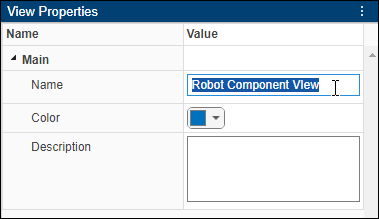
创建并添加组件
设计一个移动机械臂,通过传感器感应位置,并通过轨迹规划计算机器人需要到达的位置的路径。该系统的架构模型可由三个主要组件组成:Sensors、Trajectory Planning 和 Motion。您可以使用三个 Component 模块在 System Composer 中表示这些组件。
要创建组件,请使用以下两种方法之一。
在画布中,左键点击并拖动指针以创建一个矩形。要查看组件轮廓,请释放指针。要提交,请选择 Component。
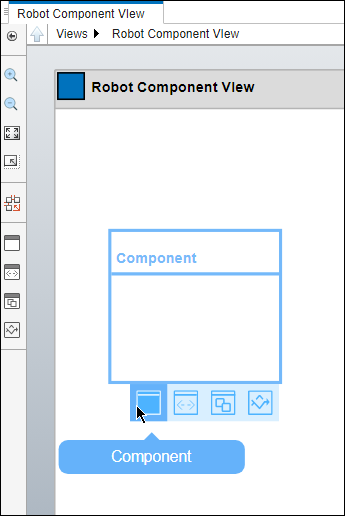
从左侧调色板中点击并拖动一个 Component 模块。
要将现有组件添加到视图中,请从模型组件中拖动组件。要从视图中删除组件,请选择一个组件。在架构视图库工具栏的组件部分,点击删除。
从组件图视图创建架构模型,您可以同时编辑多个层次结构。按下 Ctrl 键,左键点击并拖动指针到组件内,创建一个新的子组件。您还可以从顶级视图向子组件添加端口和连接。
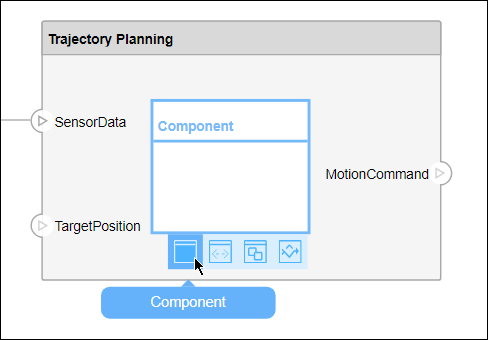
添加端口和连接
通过定义接口端口来表示组件之间的关系。您可以通过将端口放置在组件的任何边缘的任意位置来组织图。
在组件侧暂停。出现一个加号(+)和一个端口轮廓。
点击端口轮廓。一组选项将出现在
Input、Output或Physical端口。要提交端口,请选择输出。您还可以为端口命名。
通过连接器,两个组件可以进行交互,而无需定义交互的性质。在端口上设置接口来定义组件之间的交互方式。
连接是数据从输出端口流向输入端口的可视化表示。例如,从电机到传感器的连接传递位置信息。
通过拖动一条线连接两个端口:
点击其中一个端口。
在将线拖动到另一个端口时,请按住指针。
释放目标端口的指针。黑色线条表示连接已完成。如果连接不完整,将显示一条红色点线。
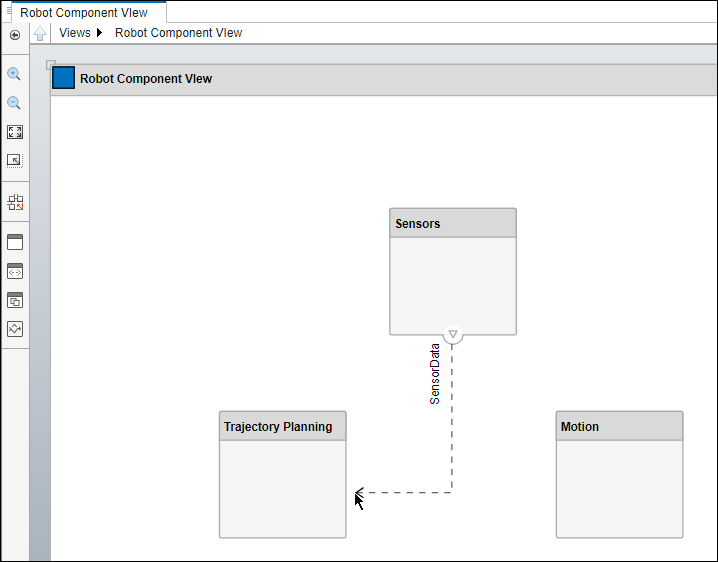
有关组成编辑的更多信息,请参阅可视化构建架构。
在架构视图中,您还可以使用连接器连接不同层次结构中的组件。

定义接口
使用接口编辑器在架构视图库中管理接口、将接口分配给端口、添加和修改数据元素以及删除接口。父架构模型反映了这些变化。
要从架构视图库工具栏中打开接口编辑器工具,在设计部分中,点击接口编辑器。
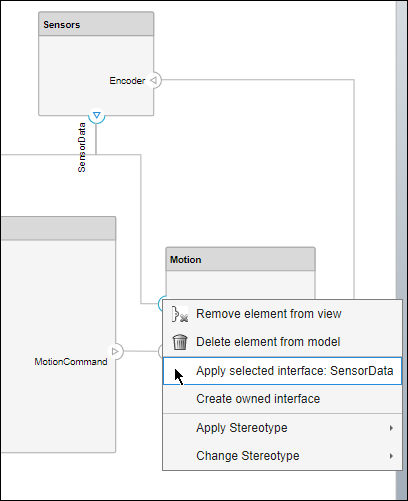
有关更多信息,请参阅创建接口和在视图中使用接口编辑器。
导入配置文件并应用构造型
使用配置文件向 System Composer 模型中的组件、端口和连接器添加属性。配置文件编辑器与模型无关,您必须将新配置文件明确导入到模型中。打开配置文件编辑器,方法是导航至 建模 > 配置文件编辑器。您可以将配置文件导入到任何打开的字典或模型中。
打开属性检查器,方法是导航至 建模 > 属性检查器。选择一个模型元素,然后从构造型列表中选择构造型。或者,右键点击模型元素,选择应用构造型,然后选择要应用于该元素的构造型。
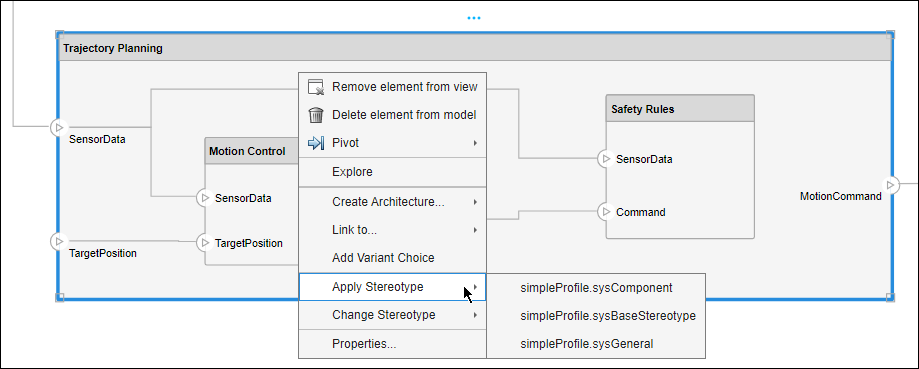
当您将构造型应用于元素时,一组新的属性会以构造型的名称出现在属性检查器中。要编辑属性,请展开该集。您可以在设计过程的后期使用配置文件、构造型和属性来查询和分析系统设计。
有关配置文件、构造型和属性的详细信息,请参阅应用构造型来扩展模型元素。
创建行为
使用 Simulink 模型引用来描述 System Composer 组件的实现。
要创建 Simulink 行为:
右键点击组件,然后选择创建 Simulink 行为。
从类型列表中选择模型引用。输入模型名称
MotionSimulink。默认名称为组件的名称。点击确定。在当前文件夹中创建了一个名为
MotionSimulink的新 Simulink 模型文件。
有关详细信息,请参阅使用 Simulink 实现组件行为。
从视图透视组合
要从视图编辑切换到模型编辑,请右键点击视图中的一个组件,然后选择 透视 > 组合,从视图中的组件切换到架构模型中的相应组件。
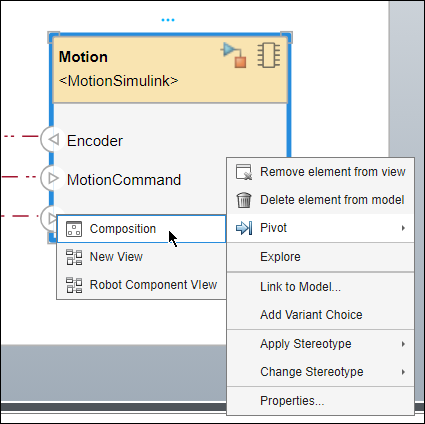
修改现有视图
使用查询定义架构模型上的自定义视角。视图过滤器依赖于查询定义的约束。在组件图视图中对端口进行分组,以简化复杂的端口和连接网络。

有关组件和端口过滤器的更多信息,请参阅交互式创建架构视图。
过滤端口
要在架构视图库中的视图中过滤组件的端口,请点击并突出显示您的组件。组件上方会出现一个蓝色框。在出现的省略号(…)处暂停,然后选择过滤器端口。
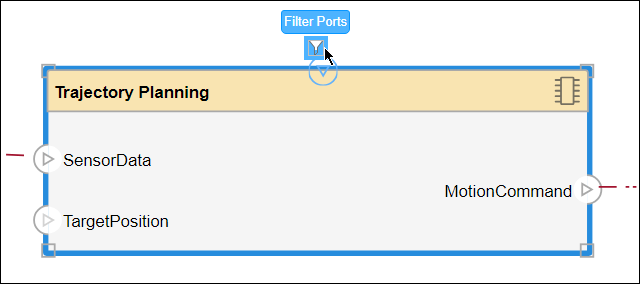
通过选中相应的复选框,选择要在视图中显示和隐藏的组件端口。

您还可以交互式地将组件添加到没有端口的视图中。
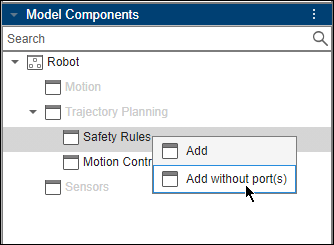
另请参阅
工具
函数
对象
systemcomposer.view.View|systemcomposer.query.Constraint|systemcomposer.interface.DataInterface|systemcomposer.interface.DataElement